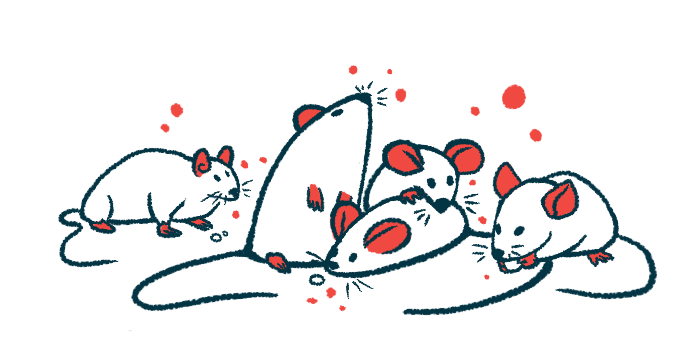Low oxygen levels in early life may trigger PH, mouse study shows
Findings may aid in developing treatments for children living at high altitudes

Researchers in the U.S. have found that exposure to low oxygen levels — known as hypoxia — early in life can cause pulmonary hypertension (PH) by permanently altering lung blood vessel development.
The team used a new mouse model they designed to better reflect a severe form of PH linked to abnormal lung development — one sometimes seen in children growing up at high altitudes. The results showed that prolonged low oxygen in the first few days of life left newborn mice with fewer and thicker lung blood vessels, setting the stage for high pressure to build up.
Moreover, the disease did not fully reverse after normal oxygen levels were restored, with the researchers noting that many features leading to the development of PH “are only partially reversible after return to air.”
These findings suggest that “early-life hypoxia disrupts critical developmental processes” involved in the formation of new lung blood vessels — a process known as angiogenesis — and their maturation, according to the research team, from Massachusetts General Hospital and Harvard Medical School.
“Our results suggest that future therapies targeting lung [blood vessels] maturation and angiogenesis may prove more effective for children living at high altitudes,” the researchers wrote.
Their study, “Prolonged Postnatal Hypoxia Impairs Lung Development and Causes Severe Pulmonary Hypertension in Mice,” was published in the Journal of the American Heart Association.
PH is a condition in which high blood pressure develops in the vessels that carry blood from the heart to the lungs, forcing the right side of the heart to work harder to pump blood. This extra strain can cause the right side of the heart to become enlarged and weaken over time, leading to common PH symptoms. If untreated, it can result in right-sided heart failure.
Exposure to hypoxia, such as in people living at high altitude, is strongly linked to PH. In adults, this usually causes the blood vessels in the lungs to thicken, raising pressure and making the heart work harder. But in infants — whose lungs are still growing — long-term hypoxia is known to potentially interfere with normal lung and blood vessel development, leading to faster disease progression and worse outcomes.
Current animal models, however, do not “reliably mimic pediatric PH resulting from impaired lung development,” the researchers wrote. This has limited the ability of scientists to fully study disease mechanisms and evaluate potential therapeutic approaches tailored to children.
Seeking to develop mouse model showing lung development in children
To develop a mouse model to closely reflect PH caused by disrupted lung development in children, a team from the nesthesia Center for Critical Care Research at Mass General and Harvard exposed mice to a low-oxygen environment at different stages of development. The environment provided oxygen levels similar to those found at high altitude.
Exposure before birth, either early or late in gestation, led to very high mortality. Thus, the team focused on hypoxia exposure starting within the first four days after birth, when the lungs are rapidly forming new air sacs and blood vessels. These mice remained on low oxygen until eight weeks of age; about 70% survived to that point, although survival dropped afterward.
These newborn-exposed mice were compared with control mice raised under normal oxygen conditions, and to adult mice exposed to low oxygen for eight weeks.
By eight weeks, the newborn-exposed mice had developed severe PH. Pressure in the lung blood vessels was very high, causing the right side of the heart to thicken as early as one week of age — earlier and more severely than in adult-exposed mice. The right side of the heart soon became enlarged and weak, with elevated heart-stress markers confirming early heart failure.
When tested on a treadmill, newborn-exposed mice tired quickly and could not run as far as healthy mice, indicating reduced exercise capacity.
This [model] provides a powerful platform for studying therapeutic interventions targeting PH, [right-heart] function, exercise capacity, and survival — key outcomes relevant to clinical practice.
“Although brief exposures may be logistically simpler and yield faster results, our study reproduced a strong [disease pattern] within [eight] weeks of hypoxic exposure,” the researchers wrote. “This provides a powerful platform for studying therapeutic interventions targeting PH, [right-heart] function, exercise capacity, and survival — key outcomes relevant to clinical practice.”
In the exposed animals, the lungs also failed to develop normally. There were fewer and larger air sacs and also fewer small lung blood vessels, with unusually thick walls, “resembling features of bronchopulmonary dysplasia,” also known as chronic lung disease of infancy, the scientists wrote. These structural abnormalities made blood flow through the lungs more difficult — a major driver of PH in this model, according to the researchers.
Even after oxygen levels were restored in adulthood, the disease did not fully reverse. Imaging tests showed some improvement in heart function, but pressure in the lung blood vessels remained high, and the right side of the heart remained enlarged, suggesting that early-life hypoxia causes lasting damage by disrupting the normal growth and maturation of lung blood vessels.
“The findings highlight the critical role of disrupted [blood vessels] development and angiogenesis in the progression of PH and provide a robust platform to study disease mechanisms and evaluate potential therapeutic interventions aimed at improving outcomes in children with PH linked to abnormal lung development,” the researchers concluded.








